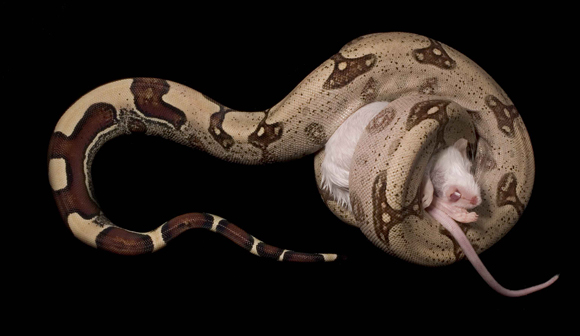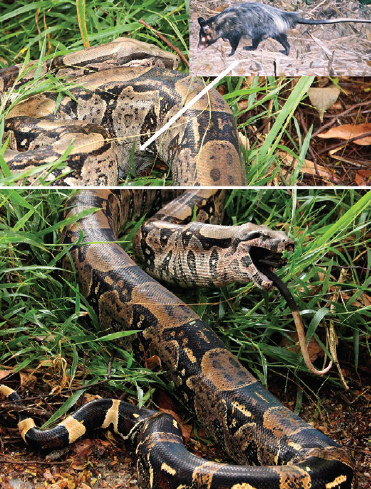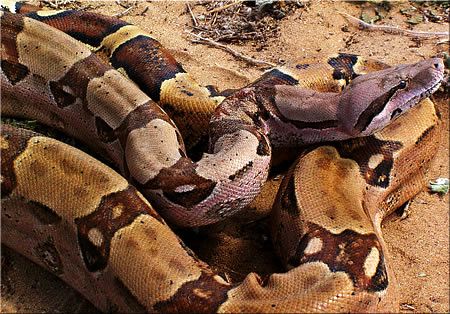Post by Ceratodromeus on Feb 8, 2017 1:50:57 GMT 5

Scientific classification
Kingdom: Animalia
Phylum: Chordata
Subphylum: Vertebrata
Class: Sauropsida
Order: Squamata
Suborder: Serpentes
Family: Boidae
Genus: Boa
Species: Boa constrictor
Recognized subspecies
The boa constrictor (Boa constrictor), also called red-tailed boa, is a species of large, heavy-bodied snake. It is a member of the family Boidae found in North, Central, and South America, as well as some islands in the Caribbean. A staple of private collections and public displays, its color pattern is highly variable yet distinctive. Nine{1} subspecies are currently recognized, although some of these are controversial.
- Red tailed boa - B.c.constrictor
- Common boa - B.c.imperator
- St.Lucia boa - B.c.orophias
- Argentine boa constrictor - B.c.occidentalis
- Pearl islands boa - B.c.sabogae
- Clouded boa - B.c.nebulosus
- Bolivian boa - B.c.armarali
- Peruvian boa - B.c.ortonii
- Long tailed boa - B.c.longicauda
Biology
The boa constrictor is a large snake, although it is only modestly sized in comparison to other large snakes, such as the reticulated python and Burmese python, and can reach lengths from 3–13 ft (0.91–3.96 m) depending on the locality and the availability of suitable prey.Clear sexual dimorphism is seen in the species, with females generally being larger in both length and girth than males. As such, the usual size of mature female boas is between 7 and 10 ft (2.1 and 3.0 m), and 6 and 8 ft (1.8 and 2.4 m) for the males. Females commonly exceed 10 ft (3.0 m), particularly in captivity, where lengths up to 12 ft (3.7 m) or even 14 ft (4.3 m) can be seen. A report of a boa constrictor growing up to 18.5 ft (5.6 m) was later found to be a misidentified green anaconda.

The size and weight of a boa constrictor depends on subspecies, locale, and the availability of suitable prey. Several populations of boa constrictors are known as "dwarf boas", such as the population of B. c. imperator on Hog Island. These smaller subspecies are generally insular populations. B. c. constrictor reaches, and occasionally tops, the averages given above, as it is one of the relatively large subspecies of Boa constrictor.
Prey includes a wide variety of small to medium-sized mammals and birds. The bulk of their diet consists of rodents, but larger lizards and mammals as big as ocelots are also reported to have been consumed. Young boa constrictors eat small mice, birds, bats, lizards, and amphibians. The size of the prey item increases as they get older and larger.

Boa constrictors are ambush predators, so often lie in wait for an appropriate prey to come along, when they attack. However, they have also been known to actively hunt, particularly in regions with a low concentration of suitable prey, and this behaviour generally occurs at night. The boa first strikes at the prey, grabbing it with its teeth; it then proceeds to constrict the prey until death before consuming it whole. Unconsciousness and death likely result from shutting off vital blood flow to the heart and brain, rather than suffocation as was previously believed; constriction can interfere with blood flow and overwhelm the prey's usual blood pressure and circulation.[16] This would lead to unconsciousness and death very quickly.[16] Their teeth also help force the animal down the throat while muscles then move it toward the stomach. It takes the snake about 4–6 days to fully digest the food, depending on the size of the prey and the local temperature. After this, the snake may not eat for a week to several months, due to its slow metabolism
Geographic distribution & habitat
Depending on subspecies, Boa constrictor can be found through Central America (Belize, Guatemala, Honduras, El Salvador, Nicaragua, Costa Rica, and Panama) to South America north of 35°S (Colombia, Ecuador, Peru, Venezuela, Trinidad and Tobago, Guyana, Suriname, French Guiana, Brazil, Bolivia, Uruguay, and Argentina), and in the Lesser Antilles (Dominica and St. Lucia), on San Andrés, Providencia and many other islands along the coasts of Mexico and Central and South America. An introduced populations exists in extreme southern Florida, and a small population on St. Croix in the US Virgin Islands now appears to be reproducing in the wild.[citation needed] The type locality given is "Indiis" – a mistake, according to Peters and Orejas-Miranda (1970).

B. constrictor flourishes in a wide variety of environmental conditions, from tropical rainforests to arid semidesert country. However, it prefers to live in rainforest due to the humidity and temperature, natural cover from predators, and vast amount of potential prey. It is commonly found in or along rivers and streams, as it is a very capable swimmer. Boa constrictors also occupy the burrows of medium-sized mammals, where they can hide from potential predators.
Reproduction
Boa constrictors are ovoviviparous, giving birth to live young. They generally breed in the dry season—between April and August—and are polygynous, thus males may mate with multiple females. Half of all females breed in a given year, and a larger percentage of males actively attempt to locate a mate.Due to their polygynous nature, many of these males will be unsuccessful. As such, female boas in inadequate physical condition are unlikely to attempt to mate, or to produce viable young if they do mate. Reproduction in boas is almost exclusively sexual. Males ordinarily have a ZZ pair of sex determining chromosomes, and females a ZW pair. In 2010, a boa constrictor was shown to have reproduced asexually via parthenogenesis. The Colombian Rainbow boa, Epicrates maurus was found to reproduce by facultative parthenogenesis resulting in production of WW female progeny. The WW females were likely produced by terminal automixis (see Figure), a type of parthenogenesis in which two terminal haploid products of meiosis fuse to form a zygote, which then develops into a daughter progeny. This is only the third genetically confirmed case of consecutive virgin births of viable offspring from a single female within any vertebrate lineage.

During the breeding season, the female boa emits a scent from her cloaca to attract males, which may then wrestle for the right to breed with her. During breeding, the male curls his tail around the female's and the hemipenes (or, male reproductive organs) are inserted. Copulation can last from a few minutes to several hours, and may occur several times over a few-week period. After this period, ovulation may not occur immediately, but the female can hold the sperm inside her for up to one year. When the female ovulates, a midbody swell can be noticed that appears similar to the snake having eaten a large meal. The female then sheds two to three weeks after ovulation, in what is known as a postovulation shed which lasts another 2–3 weeks, which is longer than a normal shed. The gestation period, which is counted from the postovulation shed, is around 100–120 days. The female then gives birth to young that average 15–20 in (38–51 cm) in length. The litter size varies between females, but can be between 10 and 65 young, with an average of 25, although some of the young may be stillborn or unfertilized eggs known as "slugs". The young are independent at birth and grow rapidly for the first few years, shedding regularly (once every one to two months). At 3–4 years, boa constrictors become sexually mature and reach the adult size of 6–10 feet (1.8–3.0 m), although they continue to grow at a slow rate for the rest of their lives. At this point, they shed less frequently, about every 2–4 months.
Reference for subspecies
{1}Reed, Robert N., and Gordon H. Rodda. Giant constrictors: biological and management profiles and an establishment risk assessment for nine large species of pythons, anacondas, and the boa constrictor. No. 2009-1202. US Geological Survey, 2009.
Original webpage
en.wikipedia.org/wiki/Boa_constrictor

















